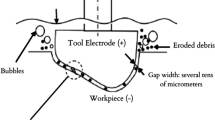Abstract
Machining of nickel alloys, particularly Monel 400 alloys, plays an important role in numerous applications of aircraft and marine industries. Machining of these alloys, with complicated shapes, through conventional machine tools is a cumbersome task. Therefore, an experimental research was made to investigate the travelling-wire electrochemical machining (TWECM) characteristics of Monel 400 alloys. TWECM has the benefit of negligible tool wear and stress-free machining. The improper removal of contaminants, mostly oxides on the specimen surface, reduces the performance of TWECM. In this direction, ozonated aqueous NaCl was used as an electrolyte in order to enhance the machining performance of TWECM. The predominant TWECM process parameters i.e. applied voltage (V), electrolyte concentration (EC) and electrolyte flow rate (U) were considered to investigate the performance measures of material removal rate (MRR) and surface roughness (R a). The microstructure of surface of the Monel 400 alloys specimen machined with TWECM was studied to understand the effect of electrolyte during the machining. Maximum of 90% increase in MRR was observed because of this new electrolyte. The surface roughness was also decreased considerably up to 32%. The contour plots were drawn to study the individual and interactive effect of process parameters on performance measures.












Similar content being viewed by others
References
Mao KW (1973) Anodic polarization study of mild steel in NaCl solution during electrochemical machining. J Electrochem Soc 120(8):1056–1060
Mao KW, Chin DT (1974) Anodic behavior of mild steel in NaClO3 at high current densities. J Electrochem Soc 121(2):191–194
Haisch T, Mittemeijer EJ, Schultze JW (2001) Electrochemical machining of the steel 100Cr6 in aqueous NaCl and NaNO3 solutions: microstructure of surface films formed by carbides. Electrochim Acta 47(1–2):235–241
Lilin SA, Balmasov AV, Shmukler MV, Rumyantsev EM (2000) Anodic behavior of Hafnium in water–alcohol solutions of sodium chloride. Prot Met 36(3):228–231
Byk MV, Tkalenko DA, Tkalenko MD (2004) On participation of hydroxide ions in the anodic dissolution of metals in aqueous electrolyte solutions. Prot Met 40(3):294–296
Silkin SA, Pasinkovskii EA, Petrenko VI, Dikusar- AI (2008) High rate anodic dissolution in chloride solutions of steel after electrothermochemical treatment. Surf Eng Appl Electrochem 44(5):343–352
Fushimi K, Kondo H, Konno H (2009) Anodic dissolution of titanium in chloride-containing ethylene glycol solution. Electrochim Acta 55(1):258–264
Davis JR (2000) ‘Corrosion-understanding the basics’. ASM International, Russell, p 563
Ayyappan S, Sivakumar K (2015) Investigation of electrochemical machining characteristics of 20MnCr5 alloy steel using potassium dichromate mixed aqueous NaCl electrolyte and optimization of process parameters. Proc Inst Mech Eng B J Eng Manuf 229(11):1984–1996
Ayyappan S, Sivakumar K (2016) Enhancing the performance of electrochemical machining of 20MnCr5 alloy steel and optimization of process parameters by PSO-DF optimizer. Int J Adv Manuf Technol 82(9):2053–2064
Ayyappan S, Sivakumar K, Kalaimathi M (2015) Electrochemical machining of 20MnCr5 alloy steel with ferric nitrate mixed aqueous NaCl. Int J Mach Mach Mater 17(1):79–94
Ghabrial SR, Ebeid SJ (1981) Beneficial effect of air-electrolyte mixtures in stationary electrochemical machining. Precis Eng. 3(4):221–223
Ayyappan S, Sivakumar K (2014) Experimental investigation on the performance improvement of electrochemical machining process using oxygen-enriched electrolyte. Int J Adv Manuf Technol 75(1–4):479–487
Kunieda M, Mizugai K, Watanabe S, Shibuya N, Iwamoto N (2011) Electrochemical micromachining using flat electrolyte jet. Ann CIRP 60:251–254
Linder HJ, Ufer PP, Heck K, Schmoger G. “Method and apparatus for electro chemical machining”. 1985. US Patent 4504370
Kalaimathi M, Venkatachalam G, Sivakumar M (2014) Experimental investigations on the electrochemical machining characteristics of monel 400 alloys and optimization of process parameters. Jordan J Mech Ind Eng. 8(3):143–151
Kalaimathi M, Venkatachalam G, Makhijani N, Agrawal A, Sivakumar M (2014) Investigations on machining of monel 400 alloys using electrochemical machining with sodium nitrate as electrolyte. Appl Mech Mater 592–594:467–472
Andrews CC, Murphy OJ. ‘Generation and delivery device for ozone gas and ozone dissolved in water’. 2006. US Patent 6,984,304 B2
Kalaimathi M, Venkatachalam G, Sivakumar M. “An experimental investigation and modeling for Traveling wire electrochemical machining of Monel 400 alloys”. Int J Manuf Technol Manag. 2017. (In press)
El-Taweel TA, Gouda SA (2011) “Performance analysis of wire electrochemical turning process—RSM approach”. Int J Adv Manuf Technol 53:181–190
Qu N, Fang X, Li W, Zeng Y, Zhu D (2013) Wire electrochemical machining with axial electrolyte flushing for titanium alloy. Chin J Aeronaut 26(1):224–229
Qu NS, Ji HJ, Zeng YB (2014) Wire electrochemical machining using reciprocated traveling wire. Int J Adv Manuf Technol 72(5–8):677–683
Trasatti S (2009) “Oxygen evolution”, electro chemical theory, reference module in chemistry, molecular sciences and chemical engineering, encyclopedia of electrochemical power sources. Elsevier Inc, Amsterdam, pp 49–55
Trasatti S (2009) “Hydrogen evolution”, electro chemical theory, reference module in chemistry, molecular sciences and chemical engineering, encyclopedia of electrochemical power sources. Elsevier Inc, Amsterdam, pp 41–49
Acknowledgement
The authors would like to acknowledge the support rendered by the Department of Science and Technology, Government of India sponsored SEM and EDS testing facility at VIT University, Vellore-632014.
Author information
Authors and Affiliations
Corresponding author
Additional information
Technical Editor: Márcio Bacci da Silva.
Rights and permissions
About this article
Cite this article
Kalaimathi, M., Venkatachalam, G., Sivakumar, M. et al. Experimental investigation on the suitability of ozonated electrolyte in travelling-wire electrochemical machining. J Braz. Soc. Mech. Sci. Eng. 39, 4589–4599 (2017). https://doi.org/10.1007/s40430-017-0748-2
Received:
Accepted:
Published:
Issue Date:
DOI: https://doi.org/10.1007/s40430-017-0748-2




